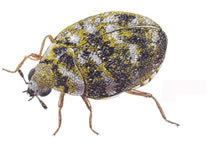
Common Pests – Carpet Beetles
Description
There are several species of carpet beetle prevalent in the UK. The most common species are the varied carpet beetle and the furniture carpet beetle. In both species, adults are normally between 2-4mm in size, and have a varied pattern of white, brown, and yellow spots or scales on their back. Mature larvae are approximately 4-5mm in size, and have a series of dense tufts of bristles and hair located on each side of the rear end of the body. These bristles give rise to their common name of ‘woolly bears’.
Lifecycle and Habits
Carpet beetles thrive in conditions where they remain undisturbed, for example beneath carpets, around skirting boards, and in wardrobes.
A female carpet beetle normally lays approximately 40 eggs, which take just over two weeks to hatch. The larvae will live and feed for a period of 7-10 months. Following this, the larvae then turns to pupa and an adult beetle will emerge approximately one month later. Adults, however, will normally only live for a period of 2-6 weeks.
What Carpet Beetles Eat
Carpet beetles can cause major damage to textiles or carpets. Larval forms of the carpet beetle can cause considerable damage to keratin-containing products such as wool, furs, leather, silk and dried animal remains. Occasionally, food products of animal origin will also be attacked, such as cereals and fibres.
Problems Linked to Carpet Beetles
Carpet beetles are a major pest to textiles, carpets or other materials they feed on. Central heating systems ensure stable temperatures, and wall-to-wall carpeting allows breeding to occur undisturbed.
They do not present significant health hazards, but in some cases, larval hairs can cause skin irritations to those exposed to large numbers.
What to look out for
They can be seen, but the presence of one or two does not necessarily indicate an infestation.
Preventing or dealing with an infestation
The wandering habits of these insects means they frequently infest wide areas, making them difficult to control. To begin with, the source of infestation must be traced. This could be found in old nests, animal remains, wool based lagging, soundproofing, wool base furnishings, or debris that has accumulated between floorboards. All infested material should be removed and disposed of where possible. Insecticide treatment is vital where infestations are intensive. This will ensure that all larvae are killed.
When insecticides are used, always follow the instructions.
Professional help
It may be advisable to contact a reputable Pest Control company, either for advice, or to carry out a professional treatment. The British Pest Control Association has a list of its member companies on its website, for all areas.